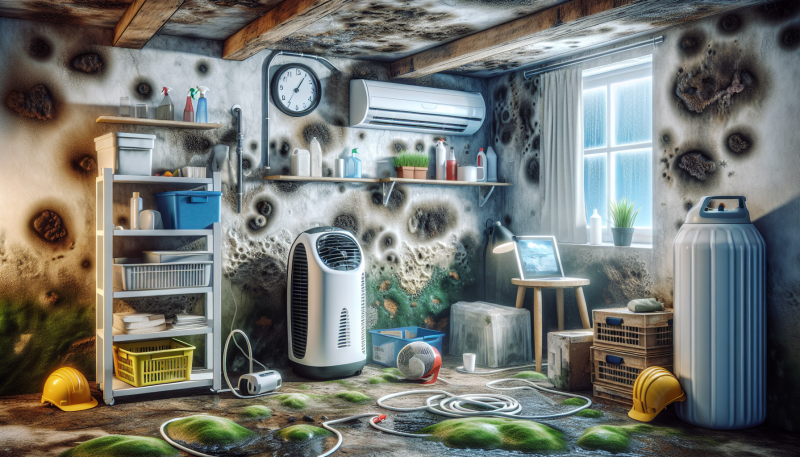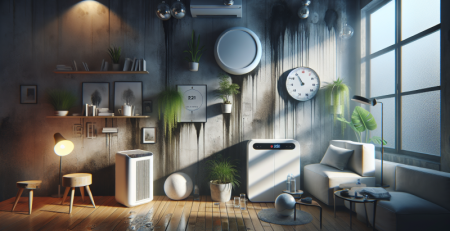Mold in Your Basement: Causes and Solutions
Mold in your basement can be a homeowner’s nightmare, leading to health issues and structural damage if not addressed promptly. Understanding the causes and solutions for basement mold is crucial for maintaining a safe and healthy living environment. At Kraus Restoration, NJ’s leaders in water, mold, and fire damage restoration, we specialize in identifying and eliminating mold problems efficiently. Our IICRC certified experts are available 24/7 for emergency services, ensuring a rapid response to any mold-related issues. Serving Central and Northern NJ, we are committed to restoring your home to its best condition. Call us at (973) 886-2021 for professional mold remediation services. In this blog, we’ll explore the common causes of basement mold and provide effective solutions to keep your home mold-free.
Understanding Mold: What It Is and Why It Grows
Mold is a type of fungus that thrives in moist, warm environments. It is a natural part of the environment and plays a crucial role in breaking down organic matter. However, when mold finds its way into your home, particularly your basement, it can become a serious problem. Understanding what mold is and why it grows is essential for effectively addressing and preventing its presence.
Mold spores are microscopic and can be found virtually everywhere, both indoors and outdoors. These spores can enter your home through windows, doors, vents, and even on your clothing or pets. Once inside, mold spores need three primary conditions to grow: moisture, a food source, and the right temperature. Basements often provide the perfect environment for mold growth due to their tendency to be damp, dark, and poorly ventilated.
Moisture is the most critical factor for mold growth. Basements are prone to moisture problems for several reasons. Water can seep through foundation walls, floors, and cracks, especially during heavy rains or due to poor drainage systems. Additionally, high humidity levels, often caused by inadequate ventilation or the presence of water sources like washing machines and water heaters, can create a conducive environment for mold. According to the Environmental Protection Agency (EPA), indoor humidity levels should be kept below 60 percent to prevent mold growth.
Mold feeds on organic materials, which are abundant in basements. Common food sources for mold include wood, paper, carpet, insulation, and even dust. When these materials become damp, they provide an ideal breeding ground for mold. The temperature in basements, typically between 60-80 degrees Fahrenheit, also supports mold growth.
The presence of mold in your basement can lead to various health issues and structural damage. Mold produces allergens, irritants, and in some cases, toxic substances known as mycotoxins. Exposure to mold can cause allergic reactions, respiratory problems, and other health issues, particularly in individuals with pre-existing conditions such as asthma or weakened immune systems. The Centers for Disease Control and Prevention (CDC) notes that mold can cause symptoms like nasal stuffiness, throat irritation, coughing, and eye irritation.
To effectively address mold in your basement, it is crucial to identify and eliminate the sources of moisture. This may involve repairing leaks, improving drainage, and using dehumidifiers to maintain appropriate humidity levels. Regular inspections and maintenance can help prevent mold growth and protect your home and health.
For professional assistance in dealing with mold, consider reaching out to experts who specialize in mold cleanup. They can provide comprehensive solutions to ensure your basement remains mold-free. Additionally, exploring the range of services offered by restoration companies can help address other related issues, such as water damage and fire cleanup.
In conclusion, understanding mold and the conditions that promote its growth is essential for preventing and addressing mold problems in your basement. By controlling moisture levels, eliminating food sources, and maintaining proper ventilation, you can create an environment that is less conducive to mold growth. For more information on mold prevention and remediation, visit the about page of our website or contact us for professional assistance.
Common Causes of Basement Mold
Basement mold is a common issue that many homeowners face, and understanding its causes is crucial for effective prevention and remediation. One of the primary causes of basement mold is moisture. Basements are naturally prone to dampness due to their location below ground level, where they are in direct contact with the surrounding soil. This soil can retain water, especially after heavy rains, leading to increased humidity and moisture seepage through the foundation walls and floors. Poor ventilation is another significant factor contributing to mold growth. Basements often lack adequate airflow, which can trap moisture and create a humid environment conducive to mold proliferation. Additionally, plumbing leaks are a frequent culprit. Leaky pipes or fixtures can introduce water into the basement, providing a perfect breeding ground for mold. Condensation is also a common issue, particularly in basements with uninsulated pipes or walls. When warm, humid air comes into contact with these cool surfaces, it can condense and create moisture that fosters mold growth. Furthermore, flooding, whether from external sources like heavy rainfall or internal sources such as a malfunctioning sump pump, can lead to significant water accumulation in the basement, promoting mold development. To address these issues, it is essential to identify and rectify the sources of moisture. Regular inspections and maintenance can help prevent leaks and ensure proper drainage around the foundation. Installing a dehumidifier can also help control humidity levels. For more comprehensive solutions, consider consulting professionals who specialize in mold cleanup and water cleanup. By addressing these common causes, homeowners can significantly reduce the risk of mold in their basements and maintain a healthier living environment. For more information on how to protect your home, visit our about page.
Identifying Signs of Mold in Your Basement
Mold in your basement can be a serious issue, leading to structural damage and health problems if not addressed promptly. Identifying signs of mold early can help you take swift action to mitigate its effects. One of the most common indicators of mold is a musty odor. This distinctive smell is often the first sign that mold is present, even if you can’t see it. Another telltale sign is visible mold growth, which can appear as black, green, or white spots on walls, ceilings, or floors. These spots may be small at first but can quickly spread if not treated. Additionally, water stains or discoloration on walls and ceilings are often precursors to mold growth, indicating that moisture is present, which is a key factor for mold proliferation.
Pay attention to any peeling or bubbling paint or wallpaper, as these can also be signs of moisture problems that lead to mold. If you notice any of these signs, it’s crucial to investigate further. Mold can also cause health issues such as respiratory problems, allergic reactions, and skin irritation. If you or your family members experience unexplained health issues, it might be worth checking for mold in your basement.
For a thorough inspection and effective mold remediation, consider professional services. Companies like Kraus Restoration offer specialized mold cleanup services to ensure your basement is mold-free. They also provide water cleanup services, which can help address the root cause of mold growth by eliminating excess moisture. If you suspect mold in your basement, don’t hesitate to contact experts who can provide a comprehensive solution to protect your home and health.
Health Risks Associated with Basement Mold
Mold in your basement is not just an unsightly problem; it poses significant health risks that can affect you and your family. Exposure to mold can lead to a variety of health issues, particularly for individuals with pre-existing conditions such as asthma, allergies, or weakened immune systems. Common symptoms of mold exposure include respiratory problems like coughing, sneezing, and shortness of breath. Mold spores can irritate the eyes, skin, nose, throat, and lungs, causing discomfort and exacerbating existing health issues. In more severe cases, prolonged exposure to mold can lead to chronic respiratory conditions, such as bronchitis or even fungal infections in the lungs. Children, the elderly, and those with compromised immune systems are particularly vulnerable to these health risks. It’s crucial to address mold issues promptly to prevent these health complications. Professional mold cleanup services can effectively remove mold and prevent its recurrence, ensuring a safer living environment. For more information on how to tackle mold problems, visit our mold cleanup page. If you suspect mold in your basement, don’t hesitate to contact us for a thorough inspection and remediation. Learn more about our comprehensive services to keep your home safe and healthy.
How to Prevent Mold Growth in Your Basement
Preventing mold growth in your basement is crucial for maintaining a healthy home environment. Mold thrives in damp, dark, and poorly ventilated areas, making basements a prime target. To effectively prevent mold growth, start by addressing any sources of moisture. This includes fixing leaks in pipes, walls, or the foundation. Ensure that your basement is properly sealed and insulated to prevent water seepage. Installing a sump pump can also be beneficial in areas prone to flooding. Additionally, using a dehumidifier can help maintain humidity levels below 60 percent, which is essential for mold prevention. Regularly clean and inspect your basement, paying close attention to corners, behind furniture, and other hidden areas where mold can grow unnoticed. Proper ventilation is also key; consider installing exhaust fans or vents to improve air circulation. If you have windows in your basement, open them periodically to allow fresh air to flow through. For more comprehensive solutions, professional services like mold cleanup can provide expert assistance in identifying and eliminating potential mold hazards. Remember, early detection and proactive measures are your best defense against mold. For additional information on maintaining a mold-free environment, you can explore our about page or contact us directly for personalized advice.
Effective Mold Removal Techniques
When dealing with mold in your basement, it is crucial to employ effective mold removal techniques to ensure a safe and healthy living environment. The first step in mold removal is to identify and address the source of moisture that is contributing to mold growth. This may involve repairing leaks, improving ventilation, or installing a dehumidifier to maintain low humidity levels. Once the moisture issue is resolved, the next step is to contain the affected area to prevent mold spores from spreading to other parts of the house. This can be done by sealing off the area with plastic sheeting and using negative air pressure to keep spores contained.
After containment, the actual removal process begins. Non-porous surfaces like metal, glass, and hard plastics can be cleaned with a mixture of water and detergent or a commercial mold cleaner. For porous materials such as drywall, insulation, and carpeting, it may be necessary to remove and dispose of the affected materials entirely, as mold can penetrate deeply into these surfaces and be difficult to eradicate completely. It is also important to use personal protective equipment (PPE) such as gloves, masks, and goggles to protect yourself from exposure to mold spores during the cleaning process.
For extensive mold infestations or for those who are not comfortable handling the removal themselves, it is advisable to seek professional help. Professional mold remediation services have the expertise and equipment to effectively remove mold and prevent future growth. They can also conduct thorough inspections to ensure that all mold has been eliminated and that the underlying moisture problem has been addressed. For more information on professional mold cleanup services, you can visit the mold cleanup page on our website.
In addition to removing existing mold, it is essential to take preventive measures to avoid future mold growth. Regularly inspect your basement for signs of moisture and mold, and address any issues promptly. Ensure that your basement is well-ventilated and that humidity levels are kept below 60 percent. You can also consider using mold-resistant products such as mold-resistant drywall and paint in areas that are prone to moisture.
By following these effective mold removal techniques and taking preventive measures, you can maintain a mold-free basement and protect the health and well-being of your household. For more information on our services and how we can help you with mold removal, please visit our services page or contact us directly.
DIY Mold Removal: Pros and Cons
When it comes to addressing mold in your basement, one option homeowners often consider is DIY mold removal. This approach has its advantages and disadvantages, which are crucial to weigh before making a decision. On the positive side, DIY mold removal can be cost-effective. By handling the task yourself, you can save on the expenses associated with hiring professional services. Additionally, it allows for immediate action. You can start the cleanup process as soon as you notice mold, potentially preventing further spread and damage.
However, there are significant drawbacks to consider. One major concern is the risk to your health. Mold spores can cause respiratory issues, allergic reactions, and other health problems, especially if you lack the proper protective gear. Furthermore, without professional training, you might not fully eradicate the mold, leading to recurring issues. Inadequate removal can also result in hidden mold growth, which can compromise the structural integrity of your home over time.
Another downside is the potential for improper handling of mold-infested materials. Professionals have the expertise to safely dispose of contaminated items, whereas DIY efforts might inadvertently spread mold spores to other areas of your home. Additionally, professional mold remediation services often come with guarantees and follow-up inspections, providing peace of mind that the problem has been thoroughly addressed.
For those who prefer to leave it to the experts, professional services like those offered by Kraus Restoration can ensure a comprehensive and safe mold removal process. They have the necessary tools, experience, and knowledge to handle mold issues effectively. If you’re unsure about the extent of the mold problem or the best course of action, it’s always a good idea to contact professionals for an assessment. For more information on the services provided, you can visit their about page.
When to Call a Professional for Mold Remediation
Mold in your basement can be a serious issue, not only for the structural integrity of your home but also for the health of its occupants. While minor mold problems can sometimes be handled with DIY methods, there are specific situations where calling a professional for mold remediation is essential. If you notice extensive mold growth covering an area larger than 10 square feet, it’s time to seek professional help. This level of infestation often indicates a deeper problem that requires specialized equipment and expertise to address effectively. Additionally, if you or anyone in your household experiences persistent health issues such as respiratory problems, allergies, or skin irritation, it could be a sign that mold is affecting your indoor air quality. In such cases, a professional assessment and remediation are crucial to ensure a safe living environment.
Another scenario that warrants professional intervention is when mold is found in hard-to-reach areas like behind walls, under flooring, or within HVAC systems. These hidden mold colonies can spread rapidly and cause significant damage if not properly treated. Professionals have the tools and knowledge to detect and eliminate mold from these concealed spaces. Moreover, if your basement has experienced water damage from flooding, leaks, or high humidity, it’s advisable to consult a professional. Water damage often leads to mold growth, and professionals can provide comprehensive water cleanup and mold remediation services to prevent future issues.
Attempting to remove mold without the proper safety gear and containment measures can also pose health risks and potentially spread mold spores to other areas of your home. Professionals follow strict protocols to ensure safe and effective mold removal, minimizing the risk of cross-contamination. If you’re unsure about the extent of the mold problem or the best course of action, it’s always better to err on the side of caution and consult a professional. They can conduct a thorough inspection, identify the root cause of the mold growth, and recommend the most appropriate remediation plan.
For more information on mold remediation and other related services, you can visit the mold cleanup section of our website. If you have any questions or need immediate assistance, don’t hesitate to contact us. Our team of experts is here to help you maintain a safe and healthy home environment.
Waterproofing Your Basement to Prevent Mold
Waterproofing your basement is a crucial step in preventing mold growth, which can lead to serious health issues and structural damage. Mold thrives in damp, dark environments, making basements particularly susceptible. To effectively waterproof your basement, start by identifying and addressing any existing moisture issues. This can include repairing cracks in the foundation, ensuring proper drainage around the perimeter of your home, and installing a sump pump to manage groundwater. Additionally, consider applying a waterproof sealant to the interior walls and floors of your basement. This creates a barrier that prevents water from seeping in. It’s also essential to maintain proper ventilation and humidity levels. Using a dehumidifier can help keep the air dry, reducing the likelihood of mold growth. Regularly inspect your basement for signs of water damage or mold, and address any issues promptly. For comprehensive solutions, you may want to consult professionals who specialize in mold cleanup and water cleanup. They can provide expert advice and services to ensure your basement remains dry and mold-free. For more information on how to protect your home, visit our about page.
The Role of Ventilation in Mold Prevention
Proper ventilation plays a crucial role in preventing mold growth in your basement. Mold thrives in environments with high humidity and poor air circulation, making basements particularly susceptible due to their underground location and limited airflow. By ensuring adequate ventilation, you can significantly reduce the risk of mold infestation. Ventilation helps to regulate humidity levels, which is essential because mold spores need moisture to grow. When air circulates effectively, it helps to dry out damp areas, preventing the accumulation of moisture that mold requires.
There are several methods to improve ventilation in your basement. Installing exhaust fans can help to expel humid air and bring in fresh air from outside. Additionally, using dehumidifiers can be highly effective in maintaining optimal humidity levels, especially in areas where natural ventilation is limited. It’s also important to ensure that your basement windows are functional and can be opened to allow for natural airflow. In cases where natural ventilation is not feasible, mechanical ventilation systems can be installed to ensure continuous air movement.
Regular maintenance and inspection of your ventilation systems are also essential. Over time, vents and fans can become clogged with dust and debris, reducing their efficiency. Cleaning these components regularly will ensure they function properly and continue to provide the necessary airflow to keep your basement dry.
Moreover, proper ventilation can also help to prevent other issues related to poor air quality, such as the buildup of harmful gases like radon. By addressing ventilation, you not only mitigate the risk of mold but also create a healthier living environment. For more information on how to maintain a mold-free basement, you can explore our mold cleanup services or contact us for professional assistance. Ensuring your basement is well-ventilated is a proactive step towards a safer and healthier home.
Using Dehumidifiers to Control Basement Humidity
Dehumidifiers are an essential tool in managing basement humidity, a critical factor in preventing mold growth. Basements are particularly susceptible to high humidity due to their location below ground level, where moisture can easily seep through walls and floors. A dehumidifier works by drawing in moist air, removing the moisture, and then releasing dry air back into the room. This process helps maintain an optimal humidity level, typically between 30 and 50 percent, which is crucial for inhibiting mold growth. By keeping the air dry, dehumidifiers reduce the likelihood of mold spores finding the damp conditions they need to thrive.
When selecting a dehumidifier for your basement, consider the size of the area and the level of humidity. Larger basements or those with significant moisture issues may require a more powerful unit. It’s also important to regularly maintain your dehumidifier by cleaning the filter and emptying the water collection container to ensure it operates efficiently. For those who prefer a more hands-off approach, many modern dehumidifiers come with features like continuous drainage options and built-in hygrometers that automatically adjust the humidity levels.
In addition to using a dehumidifier, it’s beneficial to address any underlying issues that contribute to high humidity. This includes sealing cracks in the foundation, improving drainage around the home, and ensuring proper ventilation. Combining these measures with the use of a dehumidifier creates a comprehensive strategy for controlling basement humidity and preventing mold growth. For more detailed guidance on managing basement humidity and mold prevention, consider reaching out to professionals who specialize in mold cleanup and water cleanup. Their expertise can help you implement effective solutions tailored to your specific situation. For more information about our services, visit our about page.
Mold-Resistant Building Materials for Basements
When it comes to preventing mold in your basement, choosing the right building materials is crucial. Mold-resistant building materials can significantly reduce the risk of mold growth, ensuring a healthier and more durable living space. One of the most effective materials is mold-resistant drywall, which is specially designed to withstand moisture and inhibit mold growth. This type of drywall is treated with a mold inhibitor and is ideal for areas prone to dampness, such as basements. Additionally, using mold-resistant insulation, such as closed-cell spray foam or rigid foam boards, can help prevent moisture from seeping into walls and creating a breeding ground for mold.
Another excellent option is mold-resistant paint, which contains antimicrobial agents that prevent mold spores from taking hold on painted surfaces. This type of paint can be applied to walls, ceilings, and even floors to create an extra layer of protection. For flooring, consider materials like ceramic tile, vinyl, or polished concrete, which are less likely to absorb moisture compared to traditional carpet or wood flooring. These materials are not only resistant to mold but also easy to clean and maintain.
Incorporating proper ventilation systems is also essential in maintaining a mold-free basement. Installing exhaust fans, dehumidifiers, and ensuring adequate airflow can help keep humidity levels in check, further reducing the risk of mold growth. Additionally, using water-resistant materials for basement furnishings, such as metal or plastic shelving, can prevent mold from developing on surfaces that come into contact with dampness.
For those looking to remodel or build a new basement, it is advisable to consult with professionals who specialize in mold prevention and remediation. Companies like Kraus Restoration offer a range of services that can help you choose the best mold-resistant materials and implement effective solutions to keep your basement mold-free. Their expertise in mold cleanup and prevention can provide peace of mind and ensure a healthier living environment.
In conclusion, selecting mold-resistant building materials is a proactive approach to preventing mold in your basement. By choosing the right materials and incorporating proper ventilation, you can create a space that is not only functional but also safe from the harmful effects of mold. For more information on mold prevention and to explore various projects, visit Kraus Restoration’s projects page.
Regular Maintenance Tips to Keep Your Basement Mold-Free
Maintaining a mold-free basement requires consistent effort and attention to detail. One of the most effective ways to prevent mold growth is to control the moisture levels in your basement. Start by ensuring that your basement is well-ventilated. Use dehumidifiers to keep the humidity level below 60 percent, as mold thrives in damp environments. Regularly inspect your basement for any signs of water leaks or seepage, especially after heavy rains. Pay close attention to areas around windows, pipes, and the foundation. If you notice any leaks, address them immediately to prevent water accumulation.
Another crucial step is to keep your basement clean and clutter-free. Mold can grow on various surfaces, including cardboard, wood, and fabric. Store items in plastic bins instead of cardboard boxes, and keep them elevated off the floor. Regularly clean your basement using mold-inhibiting cleaning solutions, especially in areas prone to dampness. Additionally, ensure that your gutters and downspouts are functioning correctly and directing water away from your home’s foundation. Poor drainage can lead to water pooling around your basement, increasing the risk of mold growth.
It’s also essential to check your basement’s insulation and ensure it’s in good condition. Proper insulation helps regulate temperature and moisture levels, reducing the likelihood of mold formation. If you have a sump pump, test it regularly to ensure it’s working correctly. A malfunctioning sump pump can lead to water accumulation, creating an ideal environment for mold. For more comprehensive solutions, consider consulting professionals who specialize in mold prevention and remediation. They can provide tailored advice and services to keep your basement mold-free.
For more information on how to maintain a mold-free basement, you can visit our mold cleanup services page. If you need immediate assistance or have specific questions, feel free to contact us. Additionally, you can explore our projects to see how we’ve helped other homeowners maintain healthy, mold-free environments.
Addressing Water Leaks and Flooding to Prevent Mold
Water leaks and flooding are significant contributors to mold growth in basements. When water infiltrates your basement, whether through cracks in the foundation, faulty plumbing, or natural disasters, it creates a moist environment that is ideal for mold spores to thrive. Addressing these issues promptly is crucial to prevent mold from taking hold and causing extensive damage to your property and health.
The first step in addressing water leaks is identifying the source. Common sources include cracks in the foundation, improper grading around the home, clogged gutters, and malfunctioning sump pumps. Regular inspections can help you spot these issues early. For instance, checking your basement walls and floors for cracks and ensuring that your gutters are clean and directing water away from your home can prevent water from seeping into your basement. Additionally, ensuring that the ground slopes away from your home can help keep water from pooling around your foundation.
Once you have identified the source of the water leak, it is essential to take immediate action to fix it. Small cracks in the foundation can often be sealed with waterproofing compounds, while larger cracks may require professional repair. If your gutters are the issue, cleaning them regularly and ensuring they are properly installed can prevent water from overflowing and seeping into your basement. In cases where the grading around your home is the problem, regrading the soil to slope away from your foundation can be an effective solution.
Flooding, whether from heavy rains, burst pipes, or other sources, requires a more comprehensive approach. Installing a sump pump can be a valuable investment for preventing basement flooding. Sump pumps work by collecting water that accumulates in a sump basin and pumping it away from your home. Regular maintenance of your sump pump is crucial to ensure it functions correctly when needed. Additionally, installing a backup battery for your sump pump can provide peace of mind during power outages.
In the event of a flood, immediate water removal is critical to prevent mold growth. Utilizing wet/dry vacuums, pumps, and dehumidifiers can help remove standing water and reduce humidity levels in your basement. It is also essential to thoroughly dry any affected areas, including walls, floors, and furniture. Professional water cleanup services can be invaluable in these situations, as they have the expertise and equipment to handle extensive water damage effectively. For more information on water cleanup services, you can visit Kraus Restoration’s water cleanup page.
Preventing mold growth also involves controlling the humidity levels in your basement. Mold thrives in environments with humidity levels above 60 percent. Using dehumidifiers can help maintain optimal humidity levels, especially during the warmer months when humidity tends to be higher. Additionally, ensuring proper ventilation in your basement can help reduce moisture buildup. Installing exhaust fans and ensuring that your HVAC system is functioning correctly can improve air circulation and reduce humidity.
Regularly inspecting your basement for signs of water leaks and mold growth is essential for early detection and prevention. Look for discoloration on walls and floors, a musty odor, and visible mold growth. If you notice any of these signs, it is crucial to address the issue immediately. Mold cleanup can be a complex process, and professional services can ensure that the mold is thoroughly removed and that the affected areas are properly treated to prevent future growth. For more information on mold cleanup services, you can visit Kraus Restoration’s mold cleanup page.
In addition to addressing water leaks and flooding, it is essential to consider long-term solutions to prevent mold growth in your basement. Waterproofing your basement can provide an added layer of protection against water infiltration. This process involves applying sealants to walls and floors, installing drainage systems, and using vapor barriers to prevent moisture from entering your basement. Professional waterproofing services can assess your basement’s specific needs and recommend the best solutions to keep it dry and mold-free.
Educating yourself about the causes of water leaks and flooding and taking proactive measures to address these issues can significantly reduce the risk of mold growth in your basement. Regular maintenance, prompt repairs, and professional services when needed are key components of a comprehensive approach to preventing mold. By staying vigilant and taking action at the first sign of water infiltration, you can protect your home and health from the damaging effects of mold.
For more information on how to address water leaks and flooding to prevent mold, you can explore the range of services offered by Kraus Restoration. Their team of experts can provide valuable insights and solutions tailored to your specific needs. To learn more about their services, you can visit their services page or contact them directly for personalized assistance.
Sure, here’s a suitable FAQ section for a blog topic on "Mold in Your Basement: Causes and Solutions":
FAQ: Mold in Your Basement: Causes and Solutions
Q1: What causes mold to grow in basements?
A: Mold growth in basements is primarily caused by moisture. Common sources of moisture include leaks, high humidity levels, poor ventilation, and condensation. Basements are often more susceptible to these issues due to their below-ground location, which can make them more prone to water intrusion and damp conditions.
Q2: How can I identify mold in my basement?
A: Mold can often be identified by its musty odor and visible signs such as black, green, or white spots on walls, floors, or other surfaces. It may also cause discoloration or staining. If you suspect mold but cannot see it, consider using a mold testing kit or hiring a professional to conduct an inspection.
Q3: What health risks are associated with mold exposure?
A: Exposure to mold can cause a variety of health issues, particularly for individuals with allergies, asthma, or weakened immune systems. Common symptoms include respiratory problems, skin irritation, eye irritation, and nasal congestion. Prolonged exposure can lead to more severe health problems.
Q4: How can I prevent mold growth in my basement?
A: To prevent mold growth, control moisture levels in your basement. This can be achieved by:
- Fixing leaks and sealing cracks in walls and floors.
- Using a dehumidifier to maintain humidity levels below 60%.
- Ensuring proper ventilation by installing vents or exhaust fans.
- Insulating pipes to prevent condensation.
- Regularly cleaning and maintaining gutters and downspouts to direct water away from the foundation.
Q5: What should I do if I find mold in my basement?
A: If you find mold in your basement, take the following steps:
- Identify and eliminate the source of moisture.
- Clean small areas of mold using a mixture of water and detergent, or a commercial mold cleaner. Wear protective gear such as gloves and a mask.
- For larger infestations or if you have health concerns, hire a professional mold remediation service.
- After removal, take preventive measures to avoid future mold growth.
Q6: Can I use bleach to remove mold from my basement?
A: While bleach can kill mold on non-porous surfaces, it is not recommended for porous materials like wood or drywall, as it may not penetrate deeply enough to remove all mold spores. Additionally, bleach can produce harmful fumes. Instead, use a mold-specific cleaner or consult a professional for safe and effective mold removal.
Q7: How often should I inspect my basement for mold?
A: It’s a good practice to inspect your basement for mold at least twice a year, especially during seasons with high humidity or after heavy rainfall. Regular inspections can help you catch and address mold issues early before they become more serious.
This FAQ section provides a comprehensive overview of the causes, identification, prevention, and solutions for mold in basements, helping readers understand and address this common issue effectively.









